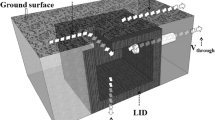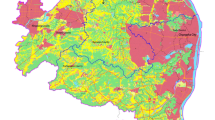Abstract
Uncertainties in nature and human society influence low impact development (LID) facility category selection during LID facility optimization distribution, however the investigation of this area is seldom. There are still two problems with uncertainty which influence LID facility distribution 1) how uncertainty factors affect LID facility selection and 2) in the case of a number of LID facilities of multiple categories are to be set, how to construct the LID facility optimization distribution model for LID facility category selection under uncertainty. To handle the problems, this study develops a fractional stochastic interval programming model to process LID facility category selection under the influence of uncertainty. The model can either process multiple objectives via objective maximization and minimization or process the stochastic uncertainty and interval uncertainty. The study shows that the uncertainties which influence LID facility category selection exist in rainfall, infiltration rate, release coefficient, unit price and budget. and the study reveal that the key constraint of LID facility category selection is the uncertainty parameter characteristic of the LID facility, in which different parameters lead to various LID facility optimization schemes. Results of the model include a series of LID facility optimization distribution schemes in multiple scenarios.Results also provide a series of feasible schemes for decision makers, and the manager can select the most appropriate scheme according to water processing level or budget. The developed model could 1) identifying the uncertainty which impact the LID facility distribution. 2) processing the LID facility category selection under interval uncertainty and stochastic uncertainty during LID facility optimization distribution. The method can also be used to estimate the rationality of the LID facility optimization scheme. Moreover, the proposed method is universal and could be extended to other cases of LID facility category selection under uncertainty.



Similar content being viewed by others
References
Amorocho J (1973) Nonlinear hydrologic analysis. Adv Hydrosci 9:203–251
Assouline S, Mualem Y (2004) Modeling Infiltration During Soil Seal Formation: Effects of Seal Non-Uniformity in Depth and Soil Heterogeneity in Space. Continuum Models and Discrete Systems 158:269–270
Cecinati F, Niet AD, Sawicka K, Rico-Ramirez M (2017) Optimal temporal resolution of rainfall for urban applications and uncertainty propagation. Water 9:0762
Chau K.W. (2017) Use of meta-heuristic techniques in rainfall-runoff modelling. Water 9,186. https://doi.org/10.3390/w9030186
Cheng CT et al (2002) Three-person multi-objective conflict decision in reservoir flood control. Eur J Oper Res 142(3):625–631
Construction Industry Research and Information Association, 2000. Sustainable urban drainage systems - design manual for Scotland and Northern Ireland. Dundee, Scotland: Construction Industry Research and Information Association Report No. C521
Damodaram C, Zechman EM (2013) Simulation-optimization approach to design low impact development for managing peak flow alterations in urbanizing watersheds. J Water Resour Plan Manag 139:290–298
Deng P, Zhu J (2016) Analysis of effective green–Ampt hydraulic parameters for vertically layered soils. J Hydrol 538:705–712
Department of Environmental Resources (1999) Low-impact development: an integrated design approach. Department of Environmental Resources, Prince George’s County, Maryland, USA
Dolinar B (2015) Prediction of the soil-water characteristic curve based on the specific surface area of fine-grained soils. Bulletin of Engineering Geology and the Environment 74 (3):697–703
Elliott AH, Trowsdale SA (2007) A review of models for low impact urban stormwater drainage. Environ Model Softw 22:394–405
Fahey L, Randal RM (1998) Learning from the future competitive foresight scenarios [M]. Wiley, New York, pp 52–55
Fletcher TD, Al E (2015) Cost–effectiveness analysis on LID measures of a highly urbanized area. Desalin Water Treat 56:2817–2823
Fotovatikhah F et al (2018) Survey of computational intelligence as basis to big flood management: challenges, research directions and future work. Eng Appl Comp Fluid 12(1):411–437
Gabellani S, Boni G, Ferraris L, Hardenberg JV, Provenzale A (2007) Propagation of uncertainty from rainfall to runoff: a case study with a stochastic rainfall generator. Adv Water Resour 30:2061–2071
Gu J, Li M, Guo P, Huang G (2016a) Risk assessment for ecological planning of arid Inland River basins under hydrological and management uncertainties. Water Resour Manag 30:1415–1431
Gu JJ, Guo P, Huang GH (2016b) Achieving the objective of ecological planning for arid inland river basin under uncertainty based on ecological risk assessment. Stoch Env Res Risk A 30:1485–1501
Gu JJ, Zhang Q, Gu DZ, Zhang QG, Pu X (2018) The impact of uncertainty factors on optimal sizing and costs of low-impact development: a case study from Beijing, China. Water Resour Manag. https://doi.org/10.1007/s11269-018-2040-3
Guo P, Huang GH (2011) Inexact fuzzy-stochastic quadratic programming approach for waste management under multiple uncertainties. Eng Optim 43:525–539
Huang, G.H., B. W. Baetz and G. G. Patry. 1998. Trash-flow allocation: planning under uncertainty. interfaces https://doi.org/10.2307/25062434
Jayasooriya VM, Ng AWM (2014) Tools for modeling of Stormwater management and economics of green infrastructure practices: a review. Water Air Soil Pollut 225:2055
Jia HF, Yao HR, Tang Y, Yu SL, Richard F, Antony N (2015) LID-BMPs planning for urban runoff control and the case study in China. J Environ Manage 149:65–76
Jia HF, Ma HT, Sun ZX, Yu S, Ding YW, Yun L (2014) A closed urban scenic river system using stormwater treated with LID-BMP technology in a revitalized historical district in China. Ecol Eng 71:448–457
Kapelan Z, Savic D, Walters GA (2003) Robust least cost design of water distribution systems using GAS. Advances in Water Supply Management (conference paper):147–155
Kaplan Z, Savic D, Walters GA (2003) Robust least cost design of water distribution systems using GAS. ADVANCES IN WATER SUPPLY MANAGEMENT ch16147–155
Lai F.-H, Dai T, Zhen J, Riverson J, Alvi K, & Shoemaker L (2007). SUSTAIN-AN EPA BMP process and placement tool for urban watersheds. Proceedings of the Water Environment Federation, 946–968
Li YP, Huang GH, Li HZ, Liu J (2015) A recourse-based interval fuzzy programming model for point-nonpoint source effluent trading under uncertainty. Jawra J Am Water Resour As 50:1191–1207
Li M, Guo P, Singh VP (2016) Biobjective optimization for efficient irrigation under fuzzy uncertainty. J Irrig Drain Eng 142:05016003
Liu Y, Ahiablame LM, Bralts VF, Engel BA (2015) Enhancing a rainfall-runoff model to assess the impacts of BMPs and LID practices on storm runoff. J Environ Manag 147:12
Loaiciga HA, Church RL (2010) Linear programs for nonlinear hydrologic estimation 1. Jawra J Am Water Resour As 26:645–656
Loáiciga HA, Sadeghi KM, Shivers S, Kharaghani S (2015) Stormwater control measures: optimization methods for sizing and selection. J Water Resour Plan Manag 141:04015006
Mishra S, Parker JC, Singhal N (1989) Estimation of soil hydraulic properties and their uncertainty from particle size distribution data. J Hydrol 108:1–18
Moazenzadeh R et al (2018) Coupling a firefly algorithm with support vector regression to predict evaporation in northern Iran. Eng Appl Comp Fluid 12(1):584–597
Peters J, Feldman A 2010. Hydrologic modeling system. Pages 3776-3781 in North American Water and Environment Congress & Destructive Water
Pierre B, Jan A (2012) Different methods to assess green infrastructure costs and benefits in housing development projects. Journal of Sustainable Development 5(4):2-21
Robinson SM (1991) Extended scenario analysis. Ann Oper Res 31:385–398
Thorne CR, Lawson EC, Ozawa C, Hamlin SL, Smith LA (2018) Overcoming uncertainty and barriers to adoption of blue-green infrastructure for urban flood risk management. J Flood Risk Manag 11:n/a–n/a
Tung YK (2017) Uncertainty analysis and risk-based design of detention basin without damage function. Water Resour Res 5(53):3576–3598
Wang WC, Chau KW, Qiu L, Chen YB (2015) Improving forecasting accuracy of medium and long-term runoff using artificial neural network based on EEMD decomposition. Environ Res 139:46–54
Whelans C, Maunsell HG, Thompson P (1994) Planning and management guidelines for water sensitive urban (residential) design. Department of Planning and Urban Development of Western Australia, Perth, Western Australia
Yaseen ZM et al (2019) An enhanced extreme learning machine model for river flow forecasting: state-of-the-art, practical applications in water resource engineering area and future research direction. J Hydrol 569:387–408
Zeng Q, Chen H, Xu CY, Jie MX, Hou YK (2016) Feasibility and uncertainty of using conceptual rainfall-runoff models in design flood estimation. Hydrol Res 47:701–717
Acknowledgements
We gratefully acknowledge financial supports for this research from projects of National Natural Science Foundation of China (Grant No. 41601581).
Author information
Authors and Affiliations
Corresponding author
Ethics declarations
Conflict of Interest
The authors declare that there are no conflicts of interest regarding the publication of this paper.
Additional information
Publisher’s Note
Springer Nature remains neutral with regard to jurisdictional claims in published maps and institutional affiliations.
Appendix
Appendix
- i :
-
the type i of LID facility
- j :
-
the location site of LID facility
- a ij :
-
the characteristics of LID facility i on site j
- b ij :
-
the characteristics of LID facility i on site j
- c ij :
-
the characteristics of LID facility i on site j
- d ij :
-
the characteristics of LID facility i on site j
- k ij :
-
the unknown decision variable of the LID facility i on site j
- r :
-
the bottom radius of percolation well
- f per :
-
permeability of percolation well
- V retained. i :
-
the retained rainwater in the LID facility i
- V through. i :
-
the rainwater that flows through the LID facility i
- V effluent :
-
the volume of effluent rainwater from the LID facility
- f per :
-
the permeability of percolation well
- V ij :
-
the effective storage of linear reservoir
- re ij :
-
The release coefficient of LID facility i on site j (unit:1/time)
- V ij :
-
The effective volume of LID facility i on site j
- ∆t :
-
The duration time of urban rainfall
- C r :
-
The rainwater pollutant contamination r
- E ijr :
-
The treated rainwater pollutant contamination r in LID facility i on site j
- ε ijr :
-
The pollution treatment efficiency of LID facility i on site j
- k ij :
-
The known variable, it means the capacity of the i − th type of LID facility at the j − th site, and the kij is predetermined and conforms to existing standard
- P ij :
-
The cost for each volume of the i − th type of LID facility at the j − th site
- F ij :
-
The fixed cost for installation of the i − th type of LID facility at the j − th siteindependent of the facility size.
- x ij :
-
The binary integer variable.
- B :
-
The total budget
- I j :
-
the volume of rain water arrive at the j − th site
- I ctrl :
-
water control standard for retained rain water
- TMDL r :
-
The regulatory r − pollution concentration of rain water discharged from the district
- Q :
-
the total volume of rain water discharged from the district
- M r :
-
the total pollution of urban rain water discharged from the district
- F :
-
Infiltration rate of LID
- h 0 :
-
Surface ponding
- K sat :
-
Saturated hydraulic conductivity of soil surface
- φ :
-
Soil suction at the wetting front
- ∆θ :
-
Difference between saturated moisture content and initial moisture
Rights and permissions
About this article
Cite this article
Gu, J., Hu, H., Wang, L. et al. Fractional Stochastic Interval Programming for Optimal Low Impact Development Facility Category Selection under Uncertainty. Water Resour Manage 34, 1567–1587 (2020). https://doi.org/10.1007/s11269-019-02422-5
Received:
Accepted:
Published:
Issue Date:
DOI: https://doi.org/10.1007/s11269-019-02422-5




